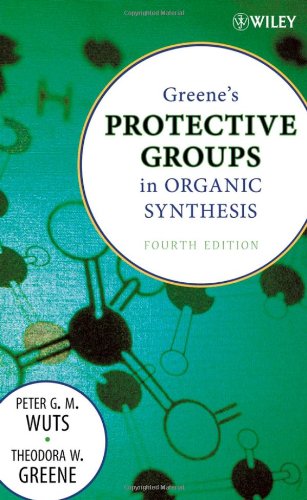Protective groups in organic synthesis ebook download
Par toothman donald le vendredi, août 26 2016, 10:51 - Lien permanent
Protective groups in organic synthesis by Peter G. M. Wuts, Theodora W. Greene


Protective groups in organic synthesis Peter G. M. Wuts, Theodora W. Greene ebook
Format: djvu
Page: 243
ISBN: 0471623016, 9780471623014
Publisher: Wiley-Interscience
In collaboration with Taylor's organic synthesis laboratory, Waldrop's group is constructing a synthetic prototype for a new antibiotic. In 2004, Waldrop's groundbreaking work with the bacterial form of ACCase, which is involved in the making of bacterial cell membranes, akin to the “skin” protecting bacteria from their outside environment, earned him an antibiotic development partnership with Pfizer, the world's largest research-based pharmaceutical company. It's not often that a book redefines a genre, but Kürti & Czakó's Strategic Applications of Named Reactions in Organic Synthesis (2005, Elsevier Academic Press) changes the landscape of named reaction books. The Rule of Six is taught in the book, Mechanisms and Structure in Organic chemistry, Edwin S. Selective Silyl Group Protection: A Possible Preparation for Scalable Extractive Separations using Acetonitrile and Hexane Phases. In a paper concerning prostaglandin synthesis [G. Protective Groups in Organic Synthesis book download. Monday, 25 March 2013 at 05:19. Wöhler's synthesis of urea in 1828 is often taken to mark the beginning of organic chemistry [1]. Gould, Holt, Rinehart, Winston 1959 pg 323. A thioketal is a very commonly used protecting group in organic chemistry because of its unique property of being stable to acid, stable to base, and only being cleaved under oxidative conditions. Kilomentor | 27 November, 2012 18: the references that I do are also old. For example, Ts2O/Yb(OTf)3 is supposed to be good to avoid that problem: Synthesis 2004, 885. Download Protective Groups in Organic Synthesis Protecting Groups - Philip J. As the technology and the company have matured, the application of fluorous methods has spread to other areas tagging of substrates using fluorous tags is a highly effective strategy for either single compound or library synthesis. Check out the section on tosylate formation in Greene's Protective Groups in Organic Synthesis. Our primary customers were industrial and academic organic chemistry labs. These tags are often fluorous versions of commonly used protecting groups such as BOC, Cbz, or silanes, and maintain reaction profiles similar to their non-fluorous analogs.